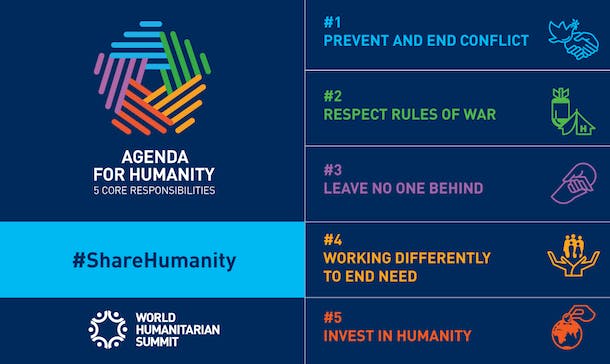
With just under 50 days until the World Humanitarian Summit in Istanbul, it’s an important time to look at the global response to humanitarian issues. Roughly 125 million people in the world today are in need of humanitarian assistance – if this were a country, it would be the 11th most populous country in the world, and the fastest growing.
We are facing the worst humanitarian crisis since the end of World War II. As we see daily in the news, the conflict in Syria is straining Europe, but around the globe – from Central America to Africa – the displaced are stretching host countries and humanitarian actors. This has increased the urgency for new approaches and reforms to the humanitarian regime. To respond, the United Nations Secretary-General has called for a World Humanitarian Summit to be held in Istanbul from May 23-24, 2016. Earlier this year, the UN Secretary-General launched his report on the Summit, laying out an Agenda for Humanity and five core responsibilities for the international community:
- Political leadership to prevent and end conflict
- Uphold the norms that safeguard humanity
- Leave no one behind
- Change people’s lives – from delivering aid to ending need
- Invest in humanity

The report is a key input to the Summit, the first of its kind to ever take place, and the five core responsibilities are intended to help governments, non-governmental groups, the private sector, and others frame their commitments to action.
The stakes for the Summit are high – and so is the need for leadership and action on humanitarian issues. As we look ahead to the start of the Summit, here are five key takeaways on the report, the Summit, and next steps for humanitarian response:
1. A new approach for the “new normal”
In the past, the international community has often waited until a crisis is too big to ignore before responding with humanitarian assistance aimed at short-term fixes. The average length of protracted crises today is about 17 years – the length of time it takes a child to complete primary and secondary education. Sadly, we must recognize that this is the new normal, and it must shape how we collectively respond.
To adapt to this new landscape, new ways of working are necessary. To bridge the humanitarian-development divide, aid organizations must engage in joint (and longer-term) planning and evaluation, working toward shared outcomes that prioritize resilience. As noted below, we need stable funding mechanisms. We must also put in place better early warning systems and respond in a timely and efficient manner to burgeoning conflicts before they erupt into unmanageable crises. This requires a hard look at the systems and infrastructure in place for strategic decision-making and resource provision.
2. Progress on the Sustainable Development Goals and humanitarian issues go hand in hand
Humanitarian response must also be viewed as a crucial element of the broader development agenda. Last year, governments agreed on the Sustainable Development Goals – a set of global goals to end poverty, build a more sustainable world, and address the impact of climate change. But as the world makes progress on development issues, fragility, conflict, and climate risks threaten progress on the goals. Without meeting the needs of these 125 million people, we will never achieve the Sustainable Development Goals. We must build on the momentum and ambition of 2015 and pledge to leave no one behind – especially those who are most in need of our help.
3. It’s about financing, not just funding
“Never before has the world been so generous, and yet never before has that generosity been so insufficient,” is how Kristalina Georgieva, Co-Chair of the High-Level Panel on Humanitarian Financing, describes the current $15 billion humanitarian financing gap. Despite the fact that the ratio of humanitarian aid within Official Development Assistance is at or above 50% in many “least developed countries,” the humanitarian system is stretched to the point of breaking.
To close the gap, we need different tools to enable investments in humanity, shifting away from individual projects to a system driven by data, needs on the ground, and clarity around outcomes.
Donors must commit to providing more predictable, long-term financing for protracted crises. In return for this investment and sustained engagement, aid organizations should commit to reducing overhead costs. It is also critical that we invest in local capacity building: Less than 2% of humanitarian funding goes to local non-governmental organizations, which are not only the first responders, but the primary aid givers in conflict settings.
The report provides several recommendations worthy of attention, including mobilizing nontraditional donors and linking humanitarian aid to longer-term development in protracted situations. We must also look at other innovative forms of financing, such as social finance, cash-based financing, and other multi-stakeholder efforts. The private sector is ripe for contribution, not just financial, but in terms of services, in-kind donations, and capabilities.
Hamdi Ulukaya, the CEO and founder of Chobani, launched his own personal organization, Tent, to focus on providing relief, promoting opportunities, and fostering partnerships to alleviate humanitarian needs. And companies like Airbnb, MasterCard, and LinkedIn are leveraging the inherent strengths of their brands – travel credits, pre-paid debit cards, and skills matching – to help those affected by the current crisis.
4. Strong political leadership for prevention, stability, and accountability
Reducing humanitarian need – not just responding to it – is a key recommendation in the report, and one that will require strong political will from world leaders. 2015 showed us that it was possible for 193 countries to agree on a universal framework for transforming the world – the Sustainable Development Goals. Ending conflicts – or preventing them from occurring – will require states to address the root causes of fragility by providing political solutions and focusing more on conflict prevention and the sources of fragility that lead to unrest and unnecessary bloodshed in the first place.
The report also calls for states to reaffirm their commitment to upholding International Humanitarian Law and the humanitarian norms that they have already agreed to. This should be top of mind for the UN and the international community. Istanbul can provide the international community with a platform to re-commit to these universal principles for civilian protection.
5. The Summit is a step in 2016 (and beyond), but not the only one
Reflecting on the acute state of humanitarian need, the Summit is a unique and timely moment to recommit to a shared agenda to humanity, agree to concrete actions that can strengthen preparedness and response, and redouble efforts to work in partnership across sectors to ensure we set ourselves on a path to heed the call of the Sustainable Development Goals to truly leave no one behind.
But we need to recognize that the Summit is one step in what must be a continued focus on our current humanitarian crisis. There are several moments throughout the year that will bring global attention to humanitarian issues, from World Refugee Day and World Humanitarian Day to two major summits in September to be convened by U.S. President Barack Obama and UN Secretary-General Ban Ki-moon, respectively. Our humanitarian crisis did not appear overnight, nor will the solutions. We will need continued attention, resources, and leadership in the years to come to make sure everyone can live a life of dignity and security.

